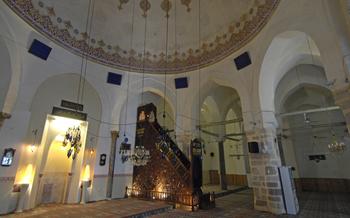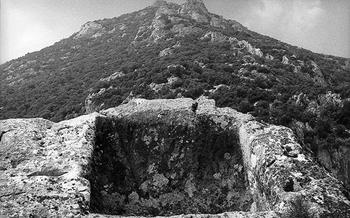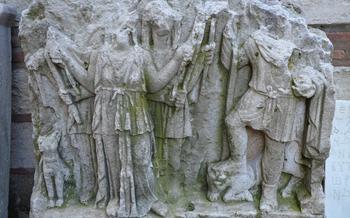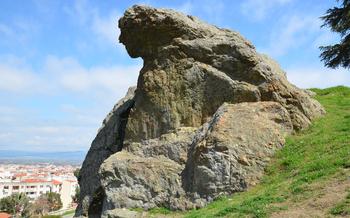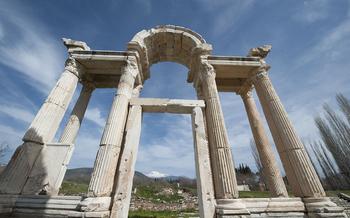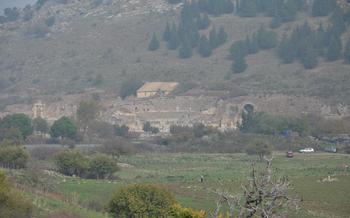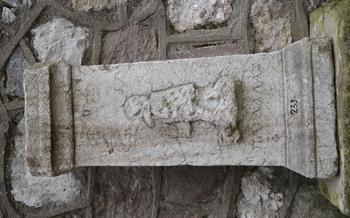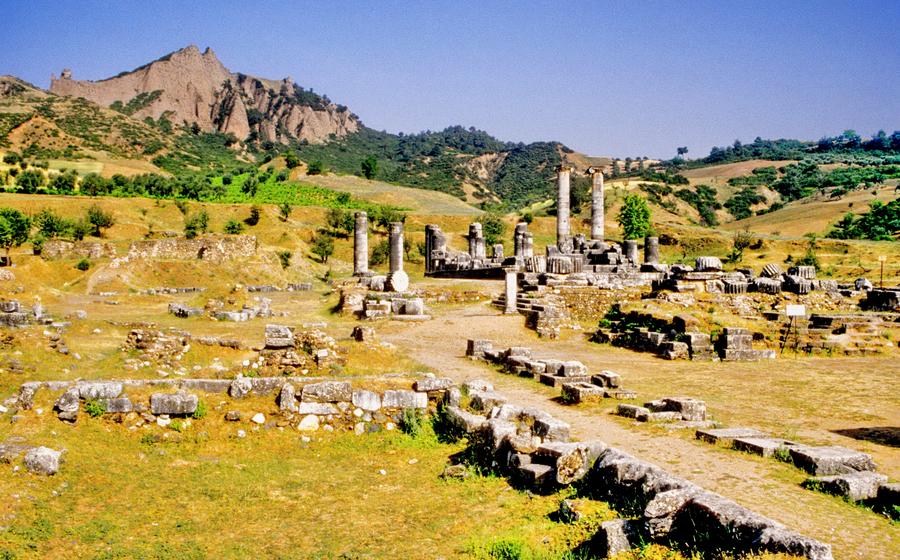
The Temple of Artemis at Sardis
- Sardis: An Ancient Lydian Kingdom
- Exploring the Temple of Artemis at Sardis
- Walk Through History at the Sardis Gymnasium
- Marvel at the Sardis Synagogue
- Discover the Acropolis of Sardis
- Uncover the Secrets of Bin Tepe Tumulus
- Admire the Sardis Theater
- Stroll Along the Pactolus River
- Indulge in Local Delights
- Shop for Souvenirs and Handicrafts
- Plan Your Visit
- Capture the Beauty
- Insider Tip: Unraveling the Hidden Gems of Manisa
Sardis: An Ancient Lydian Kingdom
Sardis, an ancient city located in western Turkey, holds significant historical importance as the capital of the ancient Lydian kingdom. During its reign in the 7th century BC, Sardis served as a prominent trading hub due to its strategic location along the trade routes connecting the Aegean Sea to the interior of Anatolia. Today, archaeological excavations in Sardis continue to unveil the grandeur of this ancient city, shedding light on its rich history and remarkable achievements. The city's connection to the biblical book of Revelation further enhances its significance, attracting visitors interested in exploring its religious and cultural heritage.
Exploring the Temple of Artemis at Sardis
The Temple of Artemis, an awe-inspiring testament to ancient Greek architecture, stands as a symbol of Sardis's religious and cultural significance. Dedicated to the goddess Artemis, the temple was constructed in the 4th century BC and served as a prominent center of worship.
Boasting an impressive rectangular plan, the temple's design exemplifies classical Greek architecture. Its grand facade, adorned with intricate carvings and sculptures, reflects the artistic prowess of its creators. Inside, visitors can marvel at the temple's spacious interior and admire the remnants of its once-ornate decorations.
Beyond its architectural splendor, the Temple of Artemis holds immense historical and religious value. Artemis, the goddess of the hunt, wilderness, and childbirth, was deeply revered by the people of Sardis. Pilgrims from far and wide flocked to the temple to pay homage to the goddess and seek her blessings.
Despite the ravages of time and natural disasters, the Temple of Artemis remains a testament to Sardis's rich past. Its ruins, preserved through meticulous restoration efforts, offer a glimpse into the religious beliefs and practices of the ancient Lydians.
Walk Through History at the Sardis Gymnasium
The Sardis Gymnasium, located near the Temple of Artemis, offers a fascinating glimpse into the sporting and educational traditions of ancient Greece. Built in the 2nd century BC, this impressive structure served as a training ground for athletes and a venue for various athletic competitions.
The gymnasium's well-preserved layout showcases a central courtyard surrounded by colonnaded walkways and rooms. The courtyard features a large open space for physical exercises, while the surrounding rooms likely served as changing rooms, storage areas, and meeting spaces for athletes and trainers.
As a vital part of ancient Greek culture, gymnasiums played a significant role in promoting physical fitness, discipline, and intellectual development. The Sardis Gymnasium would have been a hub of activity, with athletes engaging in sports such as wrestling, running, and discus throwing.
Beyond its sporting significance, the gymnasium served as an educational center. It was a place where young men received instruction in rhetoric, philosophy, and other subjects, fostering a well-rounded education that emphasized both physical and intellectual pursuits.
Today, the Sardis Gymnasium stands as a testament to the enduring legacy of ancient Greek culture. Visitors can explore its ruins and imagine the vibrant atmosphere that once filled its courtyards and walkways, gaining a deeper appreciation for the holistic educational and sporting traditions of the ancient world.
Marvel at the Sardis Synagogue
The Sardis Synagogue, a significant historical site in Manisa, Turkey, offers a glimpse into the rich cultural and religious heritage of the ancient Jewish community in Sardis. Built during the Roman period, the synagogue served as a religious and cultural center for the Jewish population that thrived in the city.
The synagogue's architectural features and design reflect the influence of both Jewish and Roman traditions. Its well-preserved remains include a prayer hall, a courtyard, and ritual baths. The prayer hall, the central space of the synagogue, features a raised platform for reading the Torah and a series of columns that divide the space into aisles.
The synagogue's significance extends beyond its religious function. It also played a crucial role as a cultural and community center for the Jewish population. Here, they gathered for religious observances, celebrated festivals, and conducted communal activities.
Today, the Sardis Synagogue stands as a testament to the vibrant Jewish community that once flourished in Sardis. Its ruins offer a unique opportunity to explore the history and heritage of this ancient civilization. Visitors can wander through the synagogue's remains, imagining the bustling atmosphere of religious services and community gatherings that once took place within its walls.
The synagogue's preservation efforts have ensured that this important historical site remains accessible to visitors. Restoration and conservation work have been carried out to protect the synagogue's structures and artifacts, ensuring that future generations can continue to appreciate its significance and beauty.
Discover the Acropolis of Sardis
The Acropolis of Sardis, a fortified upper city, stands as a testament to the ancient city's strategic and defensive importance. Perched atop a hill, the acropolis offered a commanding view of the surrounding landscape, allowing its inhabitants to keep a watchful eye on approaching threats.
The acropolis was enclosed by massive walls and fortifications, some of which remain intact to this day. These impressive structures, built with large stone blocks, showcase the engineering prowess of the ancient Lydians.
Within the acropolis, visitors can explore the ruins of various structures, including temples, administrative buildings, and residences. These remnants provide glimpses into the daily lives of the acropolis's inhabitants and the important role it played in the governance of Sardis.
From the acropolis, visitors are rewarded with stunning panoramic views of the surrounding countryside. The fertile plain of Sardis, dotted with olive groves and vineyards, stretches out before them, while the distant mountains add a majestic backdrop to the scene.
Although the acropolis is currently in a state of ruin, its historical significance and architectural remains make it a must-visit site for anyone interested in ancient history and archaeology. As you wander through the acropolis, let your imagination transport you back in time to the days when Sardis was a thriving metropolis and the acropolis stood as a symbol of its power and prestige.
Uncover the Secrets of Bin Tepe Tumulus
Bin Tepe Tumulus, located in the ancient city of Sardis, stands as a testament to the rich burial traditions and cultural practices of ancient Anatolia. As one of the largest and most well-preserved tumuli in the region, it captivates visitors with its imposing size and intriguing history.
Archaeological excavations at Bin Tepe Tumulus have unearthed a wealth of artifacts and insights into the lives and customs of the Lydian people. The tumulus is believed to have been constructed in the 6th century BC as a burial mound for a prominent Lydian ruler or high-ranking official. Its impressive size, measuring approximately 60 meters in diameter and 15 meters in height, reflects the power and prestige of the individual interred within.
The tumulus's exterior is composed of carefully arranged stones, forming a protective barrier around the burial chamber. Inside the chamber, archaeologists have discovered an array of funerary objects, including gold jewelry, pottery vessels, and bronze artifacts. These findings provide valuable clues about the wealth and status of the deceased, as well as the elaborate burial rituals practiced by the Lydians.
Bin Tepe Tumulus stands as a silent sentinel, guarding the secrets of ancient Sardis and offering a glimpse into the lives and beliefs of its long-vanished inhabitants. Its impressive size and well-preserved state make it a must-visit for anyone interested in exploring the rich history and cultural heritage of this ancient land.
Admire the Sardis Theater
The Sardis Theater, a testament to the city's vibrant cultural life, stands as a symbol of ancient Greek and Roman entertainment. Constructed during the Hellenistic period, this impressive theater once hosted a variety of performances, from theatrical plays to musical concerts.
With a seating capacity of approximately 15,000 spectators, the theater boasts an impressive architectural design. Its well-preserved stage, adorned with intricate carvings and sculptures, provides a glimpse into the grandeur of ancient performances. The theater's acoustics are equally remarkable, ensuring that the voices of actors and musicians resonated throughout the auditorium.
Over the centuries, the Sardis Theater has witnessed countless historical events and performances. Gladiatorial contests, chariot races, and religious ceremonies were among the many spectacles that captivated audiences within its walls. It is believed that the theater also served as a venue for political gatherings and public announcements.
Today, the Sardis Theater stands as a majestic reminder of the city's rich cultural heritage. Although partially restored, the theater's grandeur remains evident, inviting visitors to imagine the excitement and spectacle that once filled this ancient venue. Whether you're a history buff, a theater enthusiast, or simply seeking a glimpse into the vibrant past of Sardis, the Sardis Theater is a must-visit destination.
Stroll Along the Pactolus River
The Pactolus River, with its golden sands and historical significance, is a must-visit attraction in Sardis. In ancient times, the river served as a source of gold for the Lydians, contributing to the kingdom's wealth and prosperity. Today, visitors can stroll along the scenic riverbanks, admiring the natural beauty and tranquil surroundings.
The river meanders through the historic city, offering stunning views and endless opportunities for exploration. Take a leisurely walk or jog along the paved paths, immersing yourself in the serenity of nature. The riverbanks are adorned with lush vegetation, providing a habitat for various bird species. Birdwatching enthusiasts can spot a variety of feathered friends, including migratory birds that grace the river's ecosystem.
As you stroll along the river, let your imagination transport you back in time. Envision the Lydian gold miners panning for precious metal in the river's waters, contributing to the kingdom's legendary wealth. The river has witnessed centuries of history, from the rise and fall of civilizations to the bustling trade and cultural exchanges that took place along its banks.
For a more immersive experience, consider a boat tour or a leisurely picnic by the river. Soak in the tranquil atmosphere, listen to the gentle sounds of the water, and let the beauty of your surroundings captivate your senses. The Pactolus River is not just a natural wonder; it's a testament to Sardis' rich history and cultural heritage, waiting to be explored and cherished.
Indulge in Local Delights
Manisa, with its rich culinary heritage, offers a tempting array of traditional Turkish dishes and local specialties that are sure to tantalize your taste buds.
-
Must-Try Dishes: Begin your culinary journey with the famous Manisa Kebabı, a succulent lamb kebab prepared with local spices and herbs. Savor the flavors of Manisa Köftesi, delicious meatballs served with a tangy tomato sauce. Indulge in the sweetness of Manisa Mesir Macunu, a unique paste made from 41 different spices and known for its medicinal properties.
-
Recommended Restaurants: For an authentic dining experience, head to Köfteci Ekrem Usta, a local favorite renowned for its mouthwatering meatballs. Enjoy traditional Turkish cuisine in a charming setting at Manisa Sofrası, known for its warm hospitality and delectable dishes.
-
Culinary Experiences: Immerse yourself in the local culinary scene by participating in cooking classes or food tours. Learn the secrets of Turkish cuisine from expert chefs and discover the vibrant flavors and aromas of Manisa's culinary traditions.
Shop for Souvenirs and Handicrafts
When exploring Manisa, don't miss the opportunity to shop for unique souvenirs and handicrafts that reflect the city's rich cultural heritage. From traditional Turkish carpets and pottery to intricate jewelry and hand-woven textiles, there's something for every taste and budget.
The Kapali Carsi (Grand Bazaar) is a must-visit for souvenir shopping in Manisa. This historic market is a labyrinth of narrow streets and stalls, where you can find a vast array of goods, including handmade carpets, kilims, copperware, and leather goods. Haggling is expected and part of the shopping experience, so don't be afraid to negotiate for a good price.
For those seeking unique and authentic items, head to the Manisa Halk Pazari (Manisa People's Market). This lively market takes place every Tuesday and Friday and offers a wide variety of local produce, handmade crafts, and vintage treasures. You can find everything from traditional Turkish clothing and jewelry to hand-painted ceramics and wooden handicrafts.
To support local artisans and preserve cultural heritage, consider visiting the Manisa El Sanatlari Merkezi (Manisa Handicrafts Center). This center showcases the work of local artisans and craftsmen and offers a range of handmade products, including pottery, textiles, and woodwork. You can also watch artisans at work and learn about traditional crafting techniques.
Remember to respect local customs and traditions when shopping in Manisa. Dress modestly and be mindful of your behavior. Always ask permission before taking photos of people or their crafts. By embracing the local culture and supporting local artisans, you can create a memorable and authentic travel experience while contributing to the preservation of Turkish cultural heritage.
Plan Your Visit
Best time to visit:
Plan your visit to Manisa during the shoulder seasons (April-May and September-October) to avoid the scorching summer heat and enjoy pleasant weather for exploring the ancient sites.
Getting there:
Manisa is well-connected by air and land transportation. You can take a domestic flight to Manisa Airport (MZH) or travel by bus or train from major cities in Turkey. Once in Manisa, local transportation options such as taxis and buses are available to reach the Temple of Artemis and other attractions.
Practical Information:
-
Visa requirements: Most nationalities do not require a visa for short-term tourist visits to Turkey. However, it's advisable to check the latest visa regulations and requirements for your specific nationality.
-
Currency exchange: The official currency of Turkey is the Turkish Lira (TRY). You can exchange your currency at banks, exchange bureaus, or ATMs throughout the country.
-
Language: The official language of Turkey is Turkish. However, many people in the tourism industry speak English and other languages.
Suggested itineraries:
- One-day itinerary:
Start your day with a visit to the Temple of Artemis at Sardis. Explore the ancient ruins and learn about the history of the Lydian kingdom. In the afternoon, visit the Sardis Museum to see artifacts from the site and gain a deeper understanding of the region's past.
- Two-day itinerary:
In addition to the one-day itinerary, spend your second day exploring other attractions in Manisa, such as the Sardis Gymnasium, Synagogue, Acropolis, and Necropolis. Take a stroll along the Pactolus River and enjoy the scenic beauty of the natural surroundings.
Capture the Beauty
The ancient city of Sardis and its attractions, including the Temple of Artemis, offer a treasure trove of photographic opportunities. Capture the grandeur of the temple's ruins against the backdrop of the surrounding landscape. Experiment with different angles and perspectives to showcase the architectural details and the scale of the site.
Seek out the perfect lighting conditions, whether it's the golden glow of dawn or the soft hues of dusk, to enhance the mood and atmosphere of your images. Utilize natural light and shadows to create depth and drama in your photographs.
Don't miss the chance to capture panoramic views from the acropolis or the banks of the Pactolus River. These vantage points provide breathtaking vistas of the city and the surrounding countryside.
Share your travel experiences and stunning photographs with the world through social media platforms. Inspire others to embark on their own journey of discovery and appreciation for the rich history and beauty of Sardis.
Insider Tip: Unraveling the Hidden Gems of Manisa
Venture beyond the well-trodden tourist paths to discover the hidden gems of Manisa. Explore the lesser-known historical sites that whisper tales of a bygone era. Immerse yourself in the breathtaking natural wonders that paint a vibrant tapestry of colors and textures. Engage with the warm and welcoming locals, who are eager to share their rich culture and traditions. Savor the authentic flavors of Manisa's cuisine, indulging in culinary delights that tantalize your taste buds. Create a travel experience that is uniquely yours, filled with unforgettable moments and cherished memories.
